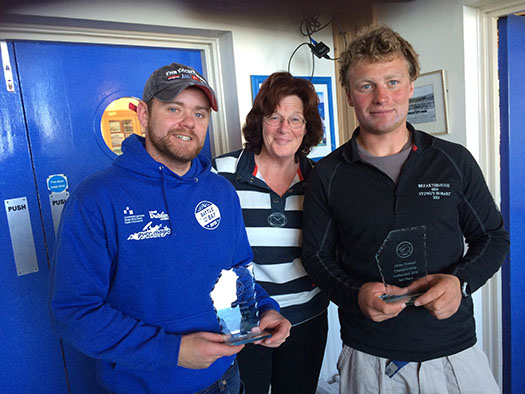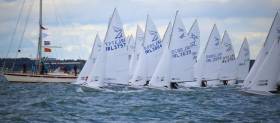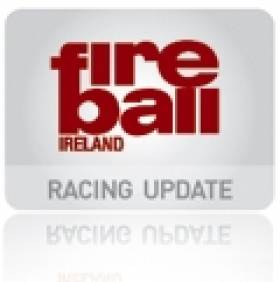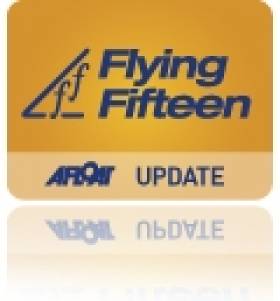Displaying items by tag: Cushendall Sailing Club
With good numbers of Flying Fifteens turning out at club level in Dublin and Strangford Lough the 20–foot keelboat class take to the road to Cushendall Sailing & Boating Club who host the Flying Fifteen Championships of Ireland this weekend, in what is one of the most picturesque settings in the country beneath the Glens of Antrim.
There is also a vibrant fleet along the north east coast in Whitehead, Larne and Cushendall.
As usual in this fleet it is very hard to call the winner as the racing is always close and exciting and any of a number of boats could win. An interesting fact in this fleet is that nobody has ever retained the trophy since it was first presented in 1986.
Current holders Dave Gorman & Chris Doorly (NYC) will be hoping to ‘buck’ that trend as they will be one of the favourites for the title.
Others hoping to stop them will be Sean Craig & Alan Green (NYC) recent winners of the South Coast Championships, Andy McCleery & Colin Dougan (KYC), Brian Willis & John McPeake, and Ian Mathews & Keith Poole (NYC) amongst others. Word is that former National champion Darren Martin & Simon Murray(SLSC) are going to compete, currently they are sailing on the SB20 circuit.
RS400 Northerns Report from Cushendall Sailing Club
23 RS400 dinghies made it to Cushendall Sailing Club in County Antrim with many travelling the full length from Cork writes David Rose. The fleet took advantage of the new lazy boy start time of 2pm that the class has chosen, to facilitate those from further afield and avoid an extra night away from domestic bliss. Seems to have been popular, with the drifting cyclonic various wind conditions for the Saturday which could have led to 6 hours of torment, being superseded by a shorter 4 hour session of torment, leaving two hours of extra mental energy to be invested in the goings on of the Cushendall Sailing Club’s shiny new bar. We like to think they rebuilt the bar for our event, so it would have been rude not to give it a suitable work out, and all retired to bed/ the Wedding Party in the local hotel, either fearful, or ignorant, of the appalling forecast for the Sunday….
Actually, star performer with two victories on Saturday, was Robin Gray, our adopted IRO, who succeeded in getting two races in before the gas officially ran out, and the great tow back in was able to commence. A stonking BBQ and quality bar staff attitude allowed for a quick turn around and racing began again about an hour later in the new bar and the rest is a distant memory.
Alex Barry, rather as one might have expected, defied the weather gods and flew around the course at twice the speed of anyone else to score two wins himself, and sealed the deal in Sunday’s tide slide with another podium to close the deal in slow style. I think we were all glad to get back ashore before scurvy set in and we all went mad, as there really was no chance to get any meaningful competition in aside from what was achieved. Only other noteworthy performance was Brian Holmes of Portcoleraine, who nailed his first top three spot in Sunday’s race. We will be expecting great things from this young man in years to come. Also great to see the local boats out again, and hopefully we will see them back on circuit again soon.
As always when we go to visit one of our less well known destinations, the stops were all pulled out, and Cushendall’s fab team left us feeling very heavily loved and pampered, and certainly well fed. Heartfelt thanks to Marc and his merry band of volunteers, you did yourselves proud.
Next up is a trip for the first time to Sligo YC in the slightly North West, for the Westerns, in late June, where hopefully sailing will be a bit livelier. Also on the go we have some local circuitry in the North and East, with a sanctioned series of one day events, mostly regattas, to keep the local activity going strong.
#fireball – Barry McCartin and Conor Kinsella have retained the Ulster Fireball Championships trophy after six races over two days in Cushendall. Second were Noel Butler and Stephen Oram and third were Kenny Rumball and Brian Tedz Byrne. Day one of the event saw lively NW winds of 12-18 knots. McCartin/Kinsella posted three wins that day on Olympic Triangular courses. Frank Miller and Ed Butler benefitted from the windy conditions and lay in fourth place overnight with two fourths and a fifth putting them ahead of team Clancy and Niall McGrotty & Neil Cramer. Further back Louise McKenna and Hermine O'Keeffe kept ahead of Mary Chambers and Brenda McGuire and local pairing of James Farrell and Terry Rowan who were sailing their first competitive event in a Fireball. Numbers at the event were disappointing at nine boats when a couple had to drop out at the last minute but for those who travelled it was a really great event.
Day two saw the winds drop a bit lighter and by the time the fleet was afloat it was quite light and a somewhat patchy, north easterly in direction. Race one saw a big shift right on the second beat and Rumball/Tedz came out of this best and led to the finish of the windward-leeward race. Miller/Butler also benefitted from that shift but threw away a second place to team Clancy by not tacking immediately at the final leeward to cover to the finish. The next 2 races took place in similar conditions but there were patches of decent wind; finding them was the trick.
Rumball/Tedz showed their talent for wind sniffing and won the third race. McCartin/Kinsella kept a solid grip on the event with two seconds on day 2 though they got badly caught by the shift in race one leaving them 6th in that discarded race. The Clancys showed better pace on day 2 and pulled ahead of Miller/Butler overall while McGrotty/Cramer didn't achieve their usual form for the conditions. The silver trophy was won by locals James Farrell and Terry Rowan, the latter sailing a Fireball for the first time. Hospitality at the club was remarkable with free food laid on after racing on Saturday night. The setting for the racing could not have been prettier this surely must be one of the nicest places to sail on the island and with the motorway making it less than 3 hours drive from Dublin it's safe to say the Fireball fleet will be back, next time with better numbers.

The silver trophy was won by local James Farrell

Brian Tedz Byrne and Kenny Rumball were third

Second were Noel Butler and Stephen Oram
#flyingfifteen – National Flying Fifteen champions Ian Mathews and Keith Poole of Dun Laoghaire could not match Roger Chamberlain and Charley Horder for Northern Championship honours at Cushendall Sailing Club today. The Strangford Lough pair moved up a gear from the last meet at Carlingford a month ago to win the 20–boat championships by four points. Results sheet available to download below.
While other east coast sailing events were becalmed the Fifteens enjoyed a good sailing breeze off the Antrim coast at Red Bay even if Saturday's winds were shifty.
Three windward leeward courses were sailed on Saturday in the lighter winds but today saw triangle courses in up to 20 knots of breeze.
Third overall in the keelboat class was another Northern Ireland based Flying fifteen, Stifflers Mom, sailed by Brian McKee and John Gibson of Portaferry.
There was applause for the excellent race management at Cushendall and also for the shoreside marshalling and local hospitality.
Full class report below:
What a weekend that was in Cushendall at the foot of the amazing Glens of Antrim. With wind and sunshine you would be forgiven for thinking we were on the continent. Twenty boats took part in The Flying Fifteen Northern Championships in the picturesque village of Cushendall at the weekend hosted by Cushendall Sailing Club. The welcome and hospitality were great and very appreciated by those who traveled. Roger Chamberlain & Charlie Horder (SLSC) won the event comfortably on the score board withr some very consistent results and could even afford to retire from the last race. Ian Mathews & Keith Poole (NYC) were second with McKee & Gibson (SLSC) third.
Saturday morning there was a light breeze, more than enough for racing but it was to be shifty in a challenging tide.
Race1: the fleet got away at first time of asking, on the beat the fleet split tacks but those on the left came in to the weather mark first, Niall & Nikki Meagher sailing Ffantastically Mr Fox(NYC) lead the way followed closely by Green/Mulligan in Frequent Flyer. Downwind they increased their lead, on the second beat the Meaghers stayed out as Green went left closer to the shore. As they tacked for the weather mark there was a drop in pressure and a major shift, the two lead boats had their spinaker's up before the mark, unfortuently for the Meaghers Green got inside as did many others who went in towards the shore. On the final run with the course shortened as the wind dropped the whole fleet bunched up but Green held on to take the gun beating over the line followed very closely by Chamberlain, McCleery, Marcus Creighton and Mulvin who all drifted towards the line faster.
Race 2: the fleet set off in shifty conditions. Midway through the race the breeze was battling with a sea breeze, the tide was strong running south towards Belfast but it was supposed to be going out! Chamberlain was going well with McCleary and Mathews going wel, also having another good race was Marcus Creighton (SSC)and Joe Coughlin (NYC) The PRO again shortened the course and the top positions didn't change, even on the last beat place were lost and gained with the shifts.
Race 3: we thought the wind had settled to a sea breeze but there were a couple of shifts shortly after the start, there was also a strong tide especially out on the right. On the beat most boats headed towards the shore, after a few short tack Gorman/Doorly (NYC) got to the weather mark first just ahead of Mulvin and Chamberlain with Mathews and McCleary close behind. The wind remained steady, on lap two Chamberlain got inside Mulvin to take second place, Mulvin sailing extremely well kept the pressure on Chamberlain but remained in third place at the finish. All three laps were completed, the first full race of the day!
Once ashore the club put on great entertainment and food, after the refreshments some crews headed up to Giants Causeway for a bit of culture others into JJ's pub also for a bit of culture. Sunday morning greeted us with beautiful sunshine and a nice breeze from the NW, perfect conditions for racing. The tide was coming in most of the morning but even though it is open sea the tide does turn well before the high water.
Race 4: the fleet got going at the second time of asking, the pin end was favoured and the majority of boats headed inshore, some including McKee went right. McKee arrived at the weather mark first just ahead of Gorman and Mathews. Today we had a triangle and the reaches were exciting. McKee held on to take the gun with Mathews second and Chamberlain third crossing the line with Gorman. Chamberlain was now in pole position to win the event.
Race 5: again the pin was favoured and most boats headed for the shore, there was an individual recall and McCleary and Chamberlain had to go back. McKee again went right. It clearly paid as he came to the weather mark followed very closely by Mathews, Gorman and Murphy. Downwind Malcom Crighton and Tom Murphy went left and went into second and third place. The next beat was again shifty with different wind strengths up the course Murphy was sailing really well and moved into second place. On the reaches some places changed but Mc Kee held on to win with Murphy second and Mathews third
The silver, bronze and classic fleet were close affairs and all the results can be seen on website www.flyingfifteen.ie. For our second regional championships, the competition in the fleet was as keen as ever with very close racing. Even though Roger and Charlie won with a race to spare the racing was incredibly close with boats crossing the line together on the water.
Roger Chamberlain thanked the club Commodore for an enjoyable event, the sponsors, the PRO and his team, his fellow competitors and even his crew Charlie who then went on to thank everybody again! A special word of thanks from from Roger in his capacity of FFAI President was for those who prepared the fantastic food and for the shore team that helped get us on and off the water. Those who didn't travel missed an enjoyable event in a fantastic setting. The next event is the Championships of Ireland which will be held in Portaferry in August.
































































